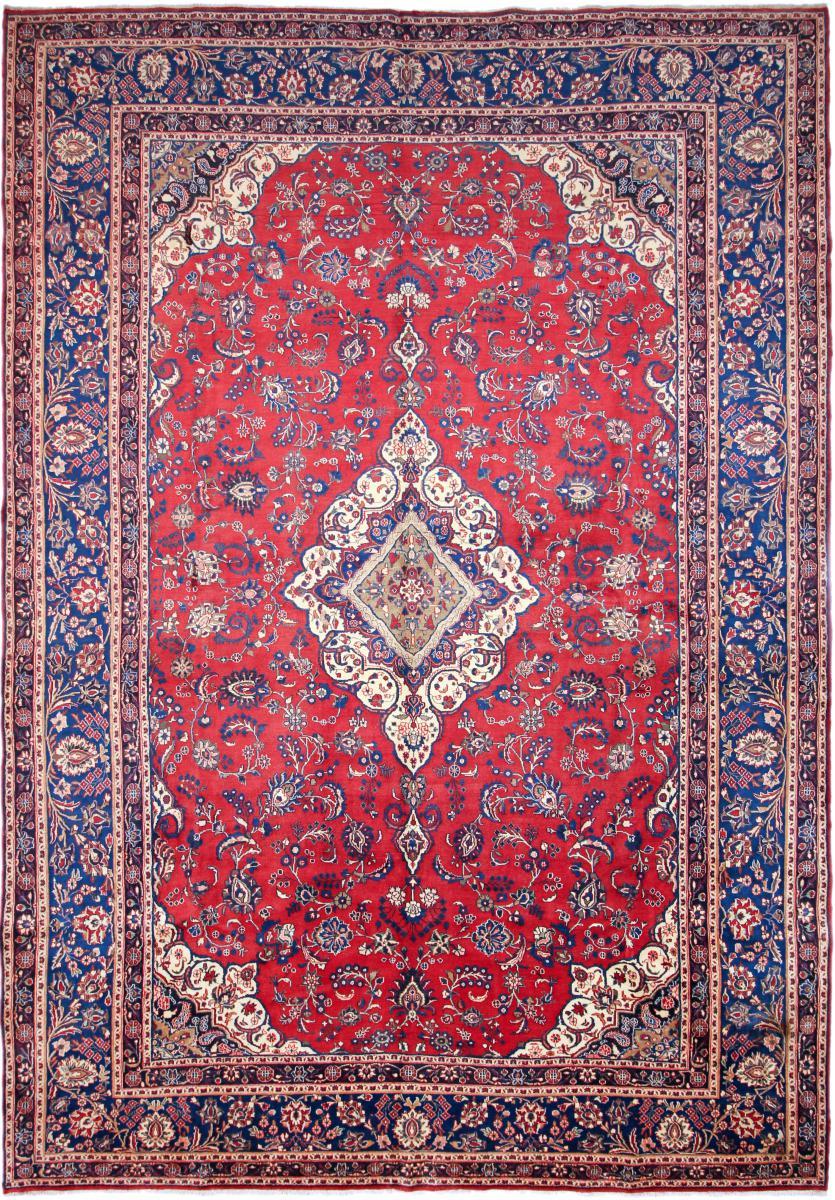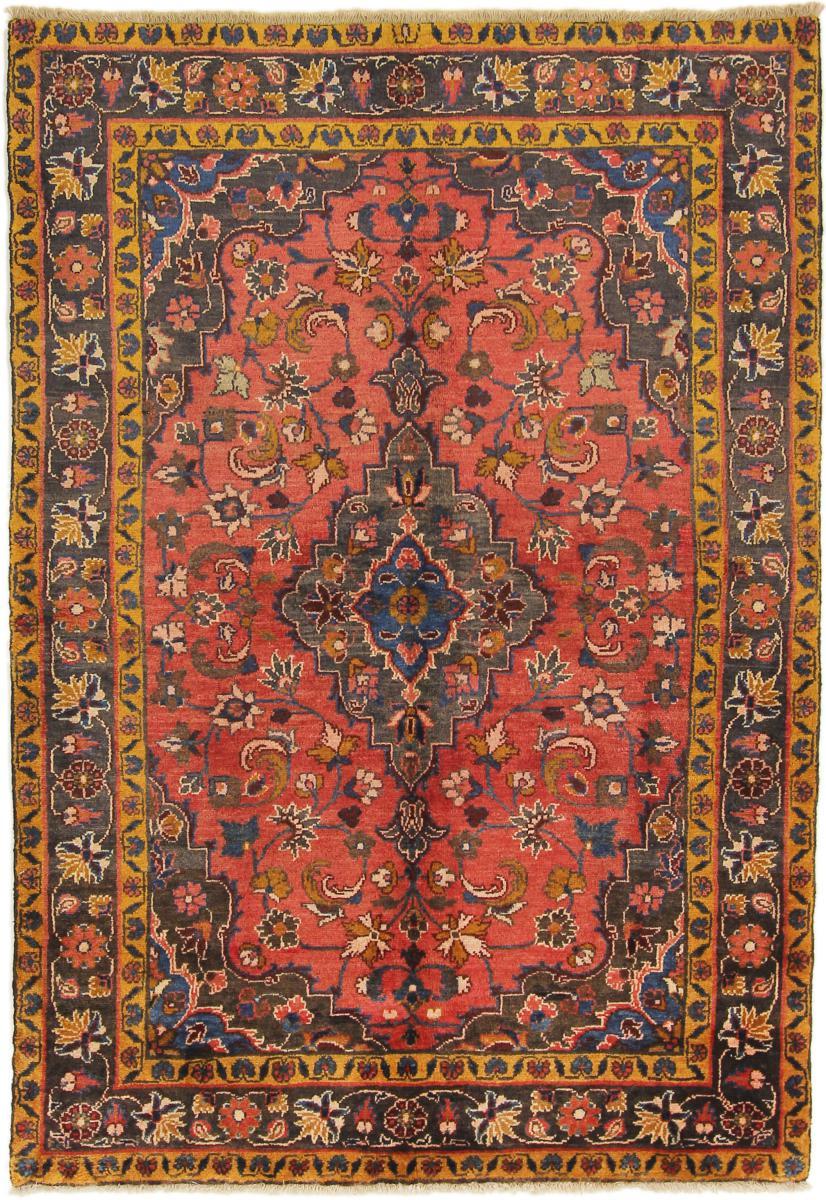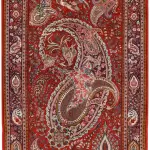Getting to know Hamadan handwoven carpet and its features
One of Hamedan's handicrafts, after the famous pottery and ceramics of Laljin, is carpet weaving, which has a very high reputation in the country and the world. Hamedan has been one of the main centers of carpet trade in the western region of the country, and carpet weaving in this region is divided into two groups, urban and rural, like most weaving centers in Iran. In this article, we will introduce Hamadan hand-woven carpet, examine its technical features and its design and role.
Background of carpet weaving in Hamadan
There is no accurate information available about the history of carpets and carpet weaving in Hamedan, because there are not enough documents and evidence in this case. But in general, it should be said that the weaving of handwoven carpets in this province has a long history. For the validity of this article, the only available evidence can be used. In the book "Carpet History", Hashmati Razavi mentions examples of carpets that can be used to estimate the history of Hamadan carpet weaving up to about 1000 years ago. Also, in the 16th century AD, that is, about 400 years ago and during the Safavid era, there was carpet weaving art in the "Darjazin" area, which is located in the Hamadan Plain. Because it is said that the Safavid Shah Tahmasab gave a piece of carpet work to his brother Shah Suleiman. Therefore, it can be concluded that during the Safavid period, the people of Hamadan were famous in this industry. In 1566 AD, the name of Hamedan carpet shines on the top of the letter of the Kingdom of Turkey, the carpets that Shah Tahmasab gave to Sultan Selim II.
Hamedan, carpet export market to Europe
Carpet weaving in Hamedan has been very prosperous and has been considered one of the major centers of carpet trade in the west of Iran since the past. Many carpets from central and western Iran have gone to Iraq and Arab cities and Europe through this route. In terms of style, the original Hamedan carpet is a rural carpet. According to Cecil Edwards, Hamedan was one of the largest carpet weaving areas in Iran, which was very important in terms of producing cheap and medium carpets. The geographical location of this city, as well as the cities of Arak and Kerman - which were important centers of carpet weaving in the country - had caused the carpet weaving of these cities to be noticed by large foreign companies that were active in the handwoven carpet business at the end of the Qajar period. At that time, the situation of carpet production in these cities was very prosperous, and foreign companies, in order to earn more money, started directly producing carpets in these cities. This issue caused the carpet production market and competition to rise in a short period of time. In the meantime, Iranian producers and traders also used the opportunity to improve their economic situation and thus, a suitable ground was created for competition in the production and sale of carpets. At this time, one of the foreign companies active in the production of carpets was "Ziegler" company, which established large carpet weaving workshops in Sultan Abad Arak after the Second World War. Parts of Hamadan and Malair were also active in this field. Hamedan city was a suitable market for the supply and sale of Sarouk, Jozan, Mehraban and Anjalas carpets.
Hamadan carpet, known as "Mosul" carpet
Hamadan carpets were known in Europe as Mosul carpets (a city in northern Iraq). It is not known why this name was given to these carpets; Maybe because the selling market of these beautiful rugs was in Mosul city. But today, Hamadan carpets are known for their size. Hamadan hand-woven carpets are divided into two groups: urban weaving and rural weaving. Most of the village braids around the cities of Hamedan, Tuiserkan and Nahavand are woven using a single weft. Of course, the villages along the Malayer-Arak road have double-woven carpets, among the examples of double-woven carpets, Jozan village can be mentioned. These weavers use the Turkish knot in carpet weaving, which is done without using a hook and with high speed and skill. The rural carpet industry has a long history compared to the urban carpet industry (around the beginning of the 20th century). Although there are similarities between urban and rural products in terms of weight and texture, these two have many differences in other cases. In general, we can say: (in terms of stylistics, the original Hamedan carpet is a rural carpet).
Technical characteristics of Hamedan carpet
In the following, we will describe the most important technical features of Hamedan carpet, such as the type of knot, the method of weaving and wefting, the type of wefting, finishing, etc.
Raw materials used
Hamedan chele and weft threads are mostly made of cotton. In very rare cases, carpets with woolen thread are also seen among the woven rural carpets of Hamadan. The pile thread of the carpets in this region is made of wool in all cases. These wools are usually sourced locally and are of high quality. This has caused Hamedan carpets to be known as high-quality and durable carpets in the market.

Index of Hamadan carpets
Although according to the writings of Cecil Edwards, the weaving of urban carpets in Hamadan province is related to the time of World War I, rural carpet weaving is of special importance. Hamadan village rugs are usually 20-30 rows and they are coarsely woven. But its urban carpet is produced in Rajshmar 30-40 and has more elegance.
The type of knot, thread, and how to pull it
Most of the carpet weavers in different carpet weaving areas of Hamadan province use Turkish knot in weaving, but the use of Persian knot is also seen in some carpets. Carpet weaving looms in different carpet weaving centers in Hamedan are all vertical and fixed, and turkish weaving is more popular. In some cases, Hamadani carpets are also woven in the Persian style. Although Hamedan is one of the most important centers of carpet weaving in Iran, carpets were produced not only in Hamedan city itself, but also in the surrounding villages, which are estimated to be around a hundred villages, and the similarity of all of them is their appearance and low price. Hamadan carpets are all woven with Turkish knot. Although at the time of World War II, Hamadani weavers began to use double or double knots in their carpets (a knot that is tied on 4 warp threads instead of 2 warps).
The method of wefting, carpet weaving and Shirazeh Pichi
The original Hamedan carpet is of a thick weft type; and they tend to weave flats. However, in the carpets that are woven in this area today, the use of two wefts with the trend of lowell weaving is also seen. In Nahavand city, carpets are often woven with a thick weft, and nowadays two wefts are also popular. Carpet weaving is done at the beginning and end of the weave, in Persian style, using a thick weft. Hamadan carpets often have shiraz attached and they are shiraz during weaving.
Interception and payment
The method of payment and covering of many Hamedan urban carpets is that they are paid after finishing weaving, but local carpets are paid while weaving and using scissors.
In what dimensions is Hamedan carpet produced?
In general, the common sizes of Hamadan carpets can be classified as follows:
- Double: these rugs are often woven in pairs.
- A cubit and a half: they are woven in the dimensions of 1 cubit and 1/5 cubit.
- Side: These rugs are woven in dimensions of 3 x 1 meter or 5 x 1 meter.
- Khark: The size of these rugs is 2 meters by 3 quarters.
- On the seat: this rug is square and 1 x 1 meter.
- Kaleghi: they are woven in dimensions of 2.5 x 3.5 meters.
- In addition, carpets measuring 2 x 3 meters, 3 x 4 meters and 3.5 x 5 meters are also woven in Hamedan.
Design and pattern in Hamadan carpet
The breadth and diversity of Hamedan carpet design and map should be considered as a result of the participation of the people and the native spirit of the villagers of different regions such as Anjalas, Bibik Abad, Derzezin, Kabodar Ahang and Bezchelo, each of them at a high level and without any doubt, a beautiful and diverse map. have produced and performed which has become famous and popular in the name of the same region. The designs woven in each village are known and sold by the name of the weaving area, which are divided by the weaving areas of the designs:
- In Anjalas, two patterns of fish are woven together.
- Bibik Abad hand-woven carpet is known for its Lach Taranj, Mahi Darham and Afshan designs.
- Meharban weavers produce machine, afshan, vase, entwined fish, bergamot and tree motifs.
- In Kabudar Ahang, the designs include repeated small bergamot, bergamot, tree, bat and tangled fish.
- In Bezchelo, they weave carpets with the motif of bergamot and mixed fish.
- Darjezin carpets are often woven with sarouqi, flower, dazah, tree, vase, and various types of lathranj motifs.
The general structure of the Hamedan carpet design
In general, the traditional designs of Hamadan regions can be divided into two groups, Lakh Taranj and Ghersari (Afshan, repetition of role) based on morphology. These two traditional designs in the region have a mythological-religious basis and are inspired by Golestan and Bagh motifs. In addition to the border and the text, the design structure of each carpet also includes the pattern. In addition to the general structure of the carpet, the design also plays the role of setting the motifs. The diversity of Naqshmayeh in Hamedan area is like other regions of Iran, which can be divided into a set of different types of plants, animals, humans, objects, buildings, etc.
The arrangement of colors in the Hamedan carpet
The results of research and scientific studies show that colors play a different role in each work of art, and specifically in each handwoven carpet as a work of art. Sometimes they are used as an emphasis on a certain subject, sometimes as the main element in the carpet, and sometimes they are arranged to show a certain feeling. Based on this, the most colors used in Hamadan carpets are often dark tones, especially black and navy. These two colors are most compatible with lacquer, white and blue colors, and they are used in Hamedan carpet texture along with these colors. The arrangement and use of colors in most Hamadan carpets is based on the extent and harmony between dark and light surfaces, the contrast of warm and cold colors, and the juxtaposition of complementary colors.
The most important weaving centers in Hamedan
Nahavand, Melayer, Tuysarkan, Anjalas, Bibik Abad, Bezchelo, Derzezin, Koboder Ahang and Mehraban are among the most important centers of handwoven carpet production in Hamedan. In the weaving of Nahavand carpets, Turkish or Persian knots are used, and dimensions of one and a half and six meters are more common in the weaving of carpets in this region. Tuiserkan is also one of the important centers of rural carpet weaving in this region, where Turkish knot is often used in its carpet weaving. These single-weave and coarse-woven carpets have simple designs and are produced in maximum dimensions of six meters. Coarsely woven rugs with a count of 20-30 are also woven in Melayer city. The type of knot in these carpets is Turkish, and cotton and woolen threads are used in them. It seems that the design of Hamedan village rugs is simpler than other nomadic carpets of Iran. Due to the use of colors, these weaves have a special value in local productions. In the urban areas of Hamedan province, Shah Abbasi and Gardan maps are used more; However, in rural areas, the motifs of fish, lace, tranj and geometric patterns are common; Although the texture of these carpets is not very delicate. One of the prominent characteristics of Hamadan village carpet is its thickness and durability, which is due to the long and dense piles of the carpet.
Final word
In a general view, it can be said that Hamedan province is one of the important carpet weaving areas of the country. Skilled carpet weavers of Hamadan produce durable and high quality carpets using local wools, which are supplied to domestic and foreign markets. Hamedan carpets offer two different weaving traditions, which include rural and urban carpets. The carpets of Hamadan province have high quality and durability in terms of having long pile and high density, and in terms of price, they are considered in the category of affordable carpets. Therefore, by buying Hamadan hand-woven carpet, although you don't need to pay a lot of money, you will have an original carpet with high quality and durability.
You can inquire about Buying Handwoven Carpets , Buying Handwoven Kilim and Mats , and Buying Handwoven Pictorial Rug Tableaus online from the Hoveida Carpet Store and register all your orders and Wherever you are in the world, deliver it to the desired address in less than 4 working days.
If you are interested in reading other articles in the field of Handwoven carpets or Handwoven Pictorial Rug Tableaus , please refer to Hoveida Carpet Commercial .
Leave a comment
Your email address will not be published. Required fields are marked *












